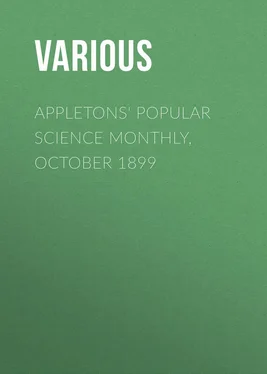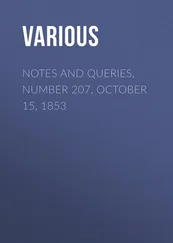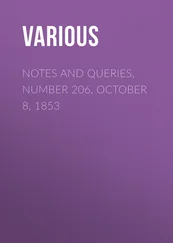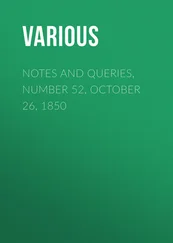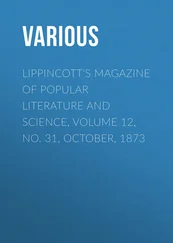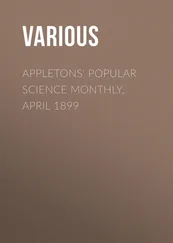Various - Appletons' Popular Science Monthly, October 1899
Здесь есть возможность читать онлайн «Various - Appletons' Popular Science Monthly, October 1899» — ознакомительный отрывок электронной книги совершенно бесплатно, а после прочтения отрывка купить полную версию. В некоторых случаях можно слушать аудио, скачать через торрент в формате fb2 и присутствует краткое содержание. Издательство: Иностранный паблик, Жанр: periodic, foreign_edu, на английском языке. Описание произведения, (предисловие) а так же отзывы посетителей доступны на портале библиотеки ЛибКат.
- Название:Appletons' Popular Science Monthly, October 1899
- Автор:
- Издательство:Иностранный паблик
- Жанр:
- Год:неизвестен
- ISBN:нет данных
- Рейтинг книги:3 / 5. Голосов: 1
-
Избранное:Добавить в избранное
- Отзывы:
-
Ваша оценка:
- 60
- 1
- 2
- 3
- 4
- 5
Appletons' Popular Science Monthly, October 1899: краткое содержание, описание и аннотация
Предлагаем к чтению аннотацию, описание, краткое содержание или предисловие (зависит от того, что написал сам автор книги «Appletons' Popular Science Monthly, October 1899»). Если вы не нашли необходимую информацию о книге — напишите в комментариях, мы постараемся отыскать её.
Appletons' Popular Science Monthly, October 1899 — читать онлайн ознакомительный отрывок
Ниже представлен текст книги, разбитый по страницам. Система сохранения места последней прочитанной страницы, позволяет с удобством читать онлайн бесплатно книгу «Appletons' Popular Science Monthly, October 1899», без необходимости каждый раз заново искать на чём Вы остановились. Поставьте закладку, и сможете в любой момент перейти на страницу, на которой закончили чтение.
Интервал:
Закладка:
Now, here was a man to whom a well-meaning but inconsiderate act of kindness had been the cause of permanent degradation. The highest qualities in such a one – manhood, self-respect, frugal and industrious independence – had been practically destroyed, and an act of charity had made of one who was doubtless originally an honest and hard-working young man, a mendicant, a loafer, and a fraud.
And yet for a sincere and self-sacrificing purpose to help our less fortunate fellow-men there were never so many inspiring and encouraging opportunities. Along with the undeniably increasing complexity of our modern life there have arisen those attractive instrumentalities for a genuine beneficence which find their most impressive illustrations in the improvements of the homes of the poor in college settlements, in young men's and young girls' clubs in connection with our mission churches, in the kindergartens and in the cooking schools founded by these and other beneficent agencies, in juvenile societies for teaching handicrafts and encouraging savings, and, best of all, in that resolute purpose to know how the other half live, of which the noble service of Edward Denison in England; of college graduates in England and in America, who have made the college and university settlements their post-graduate courses; of such women here and in Chicago as Miss Jane Addams, and the charming group of gentlewomen living in the House in Henry Street, New York, maintained with such modest munificence by Mr. Jacob Schiff; of such laborious and discerning scrutiny and sympathy as have been shown in the studies and writings of my friend Mr. Jacob Riis – are such noble and enkindling examples.
These and such as these are indicating to us the lines along which our best work for the relief of ignorance and suffering and want may to-day be done, and the more closely they are studied, and the more intimately the classes with which they are concerned are known, the more abundantly they will vindicate themselves. For these latter have in them, far more commonly than we are wont to recognize, those higher instincts of self-respect and of manly and womanly independence that, in serving our fellow-men, we must mainly count upon. There are doubtless instinctive idlers and mendicants among the poor, as, let us not forget, there are chronic idlers, borrowers, "sponges," among the classes at the other end of the social scale. But the same divine image is in our brother man everywhere, and the better, more truly, more closely we know him, the more profoundly we shall realize it. During some six weeks spent, a few years ago, in the most crowded ward in the world, among thousands of people who lived in the narrowest quarter and upon the most scanty wage, I gave six hours every day to receiving anybody and everybody who came to me. During that time I had visits from dilapidated gentlemen from Albany and Jersey City and Philadelphia and the like, who supposed that I was a credulous fool whose money and himself would be soon parted, and who gave me what they considered many excellent reasons for presenting them with five dollars apiece. But, during that whole period, not one of the many thousands who lived in the crowded tenements all around me, and to hundreds of whom I preached three times a week, asked me for a penny. Not one! They came to me by day and by night, men and women, boys and girls, for counsel, courage, sympathy, admonition, reproof, guidance, and such light as I could give them – but never, one of them, for money. They are my friends to-day, and they know that I am theirs; and, little as that last may mean to the weakest and the worst of them, I believe that, in the case of any man or woman who tries to understand and hearten his fellow, it counts for a thousandfold more than doles, or bread, or institutional relief.
THE HOPI INDIANS OF ARIZONA
As one approaches the center of Arizona, along the line of the Santa Fé Railroad, whether he come from the east or from the west, his attention is sure to be arrested by several tall, spire-like hills which are silhouetted against the sky to the far north. These peaks are the Moki Buttes, and to the north of them lies the province of Tusayan, the land of the Mokis, or the Hopis, as they prefer to be called. That country to-day contains more of interest to the student of the history of mankind than any other similar-sized area on the American continent. But very few of the great throng that roll by on the Santa Fé trains every year in quest of pleasure, of recreation, of new scenes and strange, stop off at Holbrook or Winslow to take the journey to the Hopis, and very few even know of the existence of these curiously quaint pueblos of this community, which to-day lives pretty much as it did before Columbus set out on his long voyage to the unknown West.
The term pueblo , a Spanish word meaning town, is by long and continued use now almost confined to the clusters of stone and adobe houses which to-day shelter the sedentary Indians of New Mexico and Arizona. Not only are these Indian towns called "pueblos," but we speak of the Indians themselves as the Pueblo Indians, and of the culture of the people – for they all have much in common – as the pueblo culture. This similarity of culture is not due to unity of race or of language, but is the resultant of a peculiar environment. In recent times, the limits of the pueblo-culture area have contracted to meet the demands of the white man; we know also that before the advent of the Spaniard many once populous districts had been abandoned, and as a result there came to be fewer but larger villages. We know also, both from tradition and from archæological evidence, that in former days the pueblo people inhabited many of the villages of southern Colorado and Utah, and that the Hopis and their kin were numerous in many parts of Arizona. The silent houses of the cliffs, the ruins of central Arizona, and the great crumbling masses of adobe of the Salt and Gila River valleys and in northern Chihuahua are all former habitations of the Pueblo Indian. To-day there are no representatives of these people in Utah or Colorado, while the seven Hopi towns of Tusayan alone remain in Arizona. But there are still many pueblos scattered along the Rio Grande, Jemez, and San Juan Rivers in New Mexico. Alike in culture, we may divide the existing pueblos into four linguistic groups – namely, the Hopis of Arizona, the Zuñis of New Mexico, the Tehuas east of the Rio Grande, and the Queres to the west of the Rio Grande. Of the earlier home of the last three stocks we know but little. The ancestors of the Hopis we know came from different directions – some from the cliff dwellings of the north, others from central Arizona. To-day, however, they form a congeries of clans united and welded into a unit by similarity of purpose and by the more powerful influence of a peculiar environment.
The opinion was held until within a very few years that the Hopis represented a small branch of the Shoshonean division of the Uto-Aztecan stock, but Dr. Fewkes, our greatest authority on the Hopi, has questioned the accuracy of this classification, and it can be stated that the true affinities of the Hopi have not yet been discovered.
The province of Tusayan, or the Moqui Reservation, as it is officially known to-day, contains about four thousand square miles and about two thousand Indians. It is in the northeastern part of Arizona, and its towns are about eighty miles by trail from the railroad. The present inhabitants are grouped in seven pueblos, located on three parallel mesas , or table-lands, which extend southward like stony fingers toward the valley of the Little Colorado River. The first or east mesa contains the pueblos of Walpi, Sitcomovi, and Hano; on the second or middle mesa are Miconinovi, Cipaulovi, and Cuñopavi; and on the third or west mesa stands Oraibi, largest and most ancient of all Hopi pueblos, and in many respects the best preserved and most interesting community in the world. A community without a church, separated by a broad, deep valley from its nearest neighbor, with but a single white man within twenty miles, removed nearly thirty-five miles from a trading post, isolated, proud, spurning the advances of the Government, Oraibi could maintain its independence if every other community on the earth were blotted out of existence.
Читать дальшеИнтервал:
Закладка:
Похожие книги на «Appletons' Popular Science Monthly, October 1899»
Представляем Вашему вниманию похожие книги на «Appletons' Popular Science Monthly, October 1899» списком для выбора. Мы отобрали схожую по названию и смыслу литературу в надежде предоставить читателям больше вариантов отыскать новые, интересные, ещё непрочитанные произведения.
Обсуждение, отзывы о книге «Appletons' Popular Science Monthly, October 1899» и просто собственные мнения читателей. Оставьте ваши комментарии, напишите, что Вы думаете о произведении, его смысле или главных героях. Укажите что конкретно понравилось, а что нет, и почему Вы так считаете.
